Guns are intended to help owners during a life or death situation. Therefore your chosen assault weapon should be of premium quality.
Unfortunately, selecting the right gun can be a challenging and overwhelming task, especially for novices.
While there’s an array of classy guns you can sift through, the market also boasts several strange and poorly designed guns.
The Worst Guns Every Prepper Should Avoid
Here we’ve rounded up the top 12 worst guns ever manufactured to ensure preppers remember to avoid it.
Sten Gun MK II
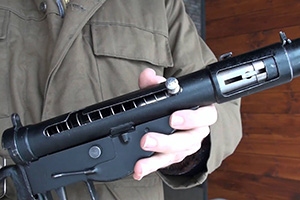 Manufactured in the United Kingdom in 1940, Britain introduced this submachine gun when facing an invasion. To combat that, the Sten Gun was designed to offer soldiers some form of protection.
Manufactured in the United Kingdom in 1940, Britain introduced this submachine gun when facing an invasion. To combat that, the Sten Gun was designed to offer soldiers some form of protection.
However, despite boasting a range of 230 feet and a capacity of 32 rounds, the gun isn’t a popular choice among preppers.
The reason being it tends to misfire, and reports show that the gun’s bullets bounced off of the target.
The Bazooka
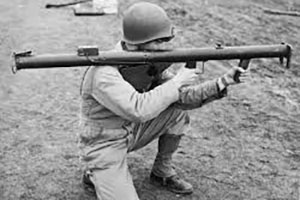 Introduced in 1942 by the US, the bazooka offers an excellent range of 500 feet.
Introduced in 1942 by the US, the bazooka offers an excellent range of 500 feet.
Unfortunately, the single-shot rocket launcher creates an enormous flare every time it’s fired. In turn, it may give away where the shooter is hiding and shoot debris, dust, and flames back at the owner.
Related: How To Hide From Thermal Vision
2mm Kolibri
The smallest centerfire cartridge pistol in history, the Kolibri, was fabricated in 1914. The pistol was named after the Colibri/hummingbird to assist in personal defense.
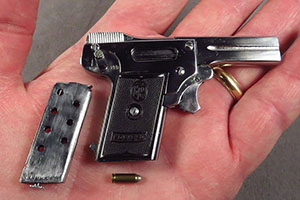
Including a 5.3g cartridge and measuring a mere 2-inches in length, this semi-automatic offers six rounds.
While the mini-sized gun is super easy to conceal and boasts little to no recoil, its small size made it virtually impossible for owners to reload and handle it.
In addition to this, the small barrel restricted owners from rifling to spin bullets, thus reducing the gun’s accuracy.
Magnum Caliber Handguns
While the Magnum Caliber Handgun is a classy and fun gun, there are some downsides to using it.
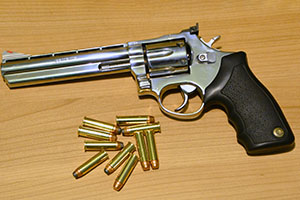
Especially for first-time shooters, the gun’s massive recoil may result in either developing a flinch or hurting yourself.
Worst of all, if you can’t handle a gun properly, you may end up accidentally shooting yourself.
In addition to this, the ammunition for Magnum handguns is relatively more expensive and may even deter learners from learning good shooting habits.
Related: How Much Ammo You Need For Practice Just To Keep Your Shooting Skills In Shape
The LeMat Grapeshot Revolver
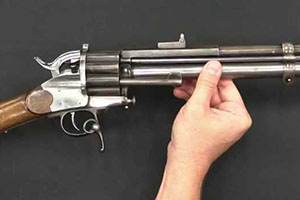 Designed in the United States in 1856, the LeMat grapeshot revolver was introduced as a cavalry weapon during the Civil War.
Designed in the United States in 1856, the LeMat grapeshot revolver was introduced as a cavalry weapon during the Civil War.
The revolver can store nine pistol rounds per revolver setup alongside a bonus barrel and a single shotgun in the center.
Therefore, owners had to switch the movable firing pin to select their desired round.
In theory, the revolver sounded like an excellent idea. In practice, it was deemed ill-conceived and challenging to use.
The Krummlauf
The Krummlauf was designed in 1943 by the Germans to shoot around the corners.
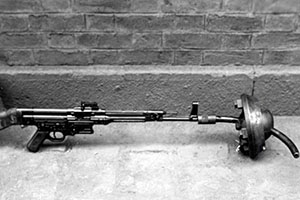
The intricately crafted weapon is curved and can be clamped atop the barrel of anStG 44 (or Mp-44) rifle.
The original idea was that with the Krummlauf gun, soldiers could shoot while in cover or inside a tank. Thus, the weapon comes in four different versions, which were 30 degrees, 45 degrees, 60 degrees, and 90 degrees.
While the curved design of the Krummlauf looked pretty cool, it also meant that the bullets had to travel around a bend. Which often resulted in the bullets either shattering and cracking the barrel. The manufacturer introduced additional modifications to the weapon, such as installing vent holes to lower recoil and pressure. However, the Krummlauf still sustained damage.
The Apache Revolver
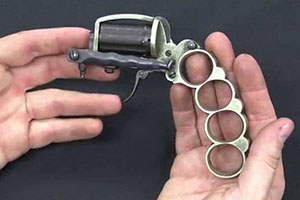 Launched in 1860, the Apache revolver obtained its name from the French gangs who helped popularise the gun. The gun sounded incredible as it combines a six-shot revolver with a knife and brass knuckles.
Launched in 1860, the Apache revolver obtained its name from the French gangs who helped popularise the gun. The gun sounded incredible as it combines a six-shot revolver with a knife and brass knuckles.
Unfortunately, the folding triangular blade installed in the gun led to removing the gun’s barrel.
In turn, shots fired from the gun were inaccurate and overall challenging to make.
Not to mention, reloading the gun meant owners had to remove the whole cartridge cylinder and replace it. The trigger guard and safety of the revolver were also missing.
Chauchat Light Machine Gun
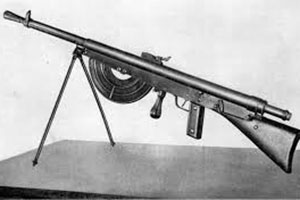 Fabricated in 1915 by the French during World War I, the Chauchat light machine gun was poorly designed. In fact, the firing mechanism of the machine gun jammed every two seconds.
Fabricated in 1915 by the French during World War I, the Chauchat light machine gun was poorly designed. In fact, the firing mechanism of the machine gun jammed every two seconds.
On the flip side, if the gun did end up working adequately, its 20-round capacity was insufficient fighting.
Related: 6 Best Guns to Have After an EMP
The Gyrojet Pistol
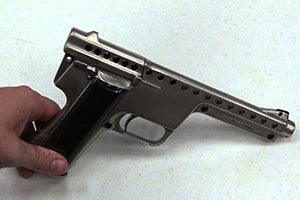 The Gyrojet pistol was introduced in 1965 in the US and boasted one of the most creative designs. Moreover, the handgun featured a range of 165 feet and fired via an innovative rocket propulsion technique.
The Gyrojet pistol was introduced in 1965 in the US and boasted one of the most creative designs. Moreover, the handgun featured a range of 165 feet and fired via an innovative rocket propulsion technique.
The drawback was that these guns were super inaccurate, which isn’t ideal in combat.
The Mars Pistol
During the 20th century, gun inventors in the UK strived to fabricate a self-loading pistol.
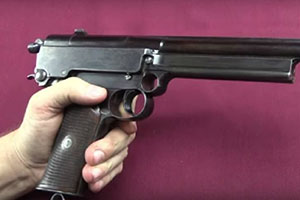
Their efforts ultimately led to the development of the Colt m1911. However, before that, they crafted the Mars pistol.
This extremely complicated handgun would shoot used cartridges into the owner’s face. Its production halted soon, but at least 80 pistols had already been manufactured.
The Colt 1885 Revolving Rifle
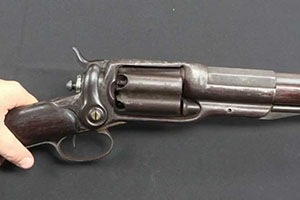 In the 19th century, an American inventor Samuel Colt introduced the modern revolver, offering about six fast-firing shots before reloading.
In the 19th century, an American inventor Samuel Colt introduced the modern revolver, offering about six fast-firing shots before reloading.
The creative design and revolutionary technology of the handgun ended up becoming the standard pattern of handguns.
Inventors decided to combine revolver-level firepower with rifles, which led to the Colt 1855 revolving rifle’s manufacture. Unfortunately, unlike his first invention, the revolving rifle proved to be of low quality.
The loud noise of the gun alongside the revolver-cylinder system’s open nature put the user’s life in danger. Since these weapons are close to the owner’s face, a mechanical failure or explosions could easily lead to devastating repercussions.
Related: Awesome Places to Hide Your Guns
The Colt 2000
The Colt 2000 was designed as a substitute for the Austrian Glock pistol and was one of the company’s worst guns. Developed by leading gun designers Eugene Stoner and Reed Knight Jr., the gun looked incredible in theory.
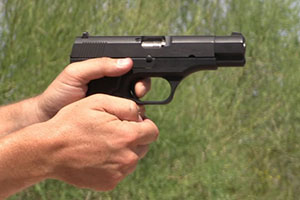
The weapon boasted an elegant polymer frame alongside a meta slide to reduce weight, a double-stacked magazine with the ability to hold fifteen rounds, and a striker-fired design.
The drawback was that the gun lacked reliability and security. Not only did users experience frequent jamming, but the gun offered low accuracy as well. As a result, the gun lasted a mere four years in the industry.
Final Thoughts
Purchasing sufficient and appropriate weaponry is no easy task. Especially since the market offers a wide array of options, it’s increasingly difficult for Preppers to pinpoint which guns are the best and which aren’t so good.
However, doing an in-depth reading and thoroughly checking the different gun features allows owners to discern whether their selected gun is of premium quality or the exact opposite.
Above we mentioned a plethora of guns preppers should avoid due to their poor design and low-quality features. Moreover, it’s critical to choose high-quality guns to ensure your safety in case of a gunfight.
You may also like:
The 5 Best Pocket Handguns For Self-Defence
This “Quick Fix” Is More Effective In Keeping Out Looters Than A Solid Steel Door (Video)

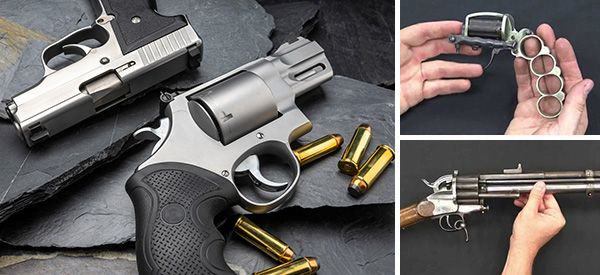
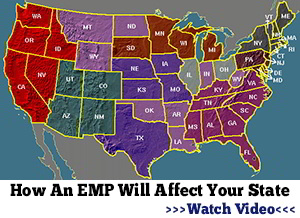













you didn’t mention the US military “Sten gun” >> the M3 Johnson “grease gun” – pity the poor SOB that got issued one for combat ….
Preppers know what guns they want. It is common knowledge which ones are useless bits of crap. The important things to consider besides quality and efficiency is the availability of spare parts and ammo. Guns aren’t all that matter in survival they just seem to be most on people’s minds.
You are absolutely right Vinny! The very most important item to have in a survival situation is the ability to make a fire! Without a fire things are only going to go from bad to worse especially if you have children.
The M3 was a good gun, operated in crappy conditions, when suppressed it was better then the MP5. The Sten was accurate out to 200 meters. I’ve carried both in hostile areas.
You don’t really think the average person has access to purchase any of these laughable weapons do you…..
The magnum wheel gun may not be as handy as some others but,if I’m shooting at distance I want my 357 with a 6″ barrel.
Every weekend some place in the U.S. folks are lined up on the firing line shooting at steel targets shaped like a sheep at 200 meters with revolvers. Mostly they are .44 magnums. The .357 Maximum was supposed to replace the .44 Mag but unfortunately, top strap cutting problems in revolvers led to its early demise. Still worked well in Thompson Contender barrels.
With experience and practice, 200 meter shots with 6 inch or 8 inch barrel on a revolver are not out of the realm of the probability of scoring hits. The key words are “experience” and “practice”
Can’t be any worse then the junk 1911
I can’t believe all the 1911 haters out there, bold enough to show their ignorance regarding a firearm that has been around for 109 years. Was and regarded highly by the US government. And still is by some forces. Is one of the most copied firearms, and now made in most calibers …. yeah, must be a junk gun.
Unlike many experts, I carry a 1911 in combat. It never failed me and I never felt under-gunned. It is a fine weapon and time proven.
A 100 years ago sure
You are aware that the 1911 was introduced in 1911? Never mind … you are troll with no knowledge of firearms … say what you will …. ignorance I suppose is bliss.
Yeah thus the reply of a 100 years ago. Its a relic outdated range toy.
Imagine thinking nothing improved in a 100 years
Hammers? Way over 100 years old.
You must be the happiest person on earth!
You carried it all right and never used it
RMac,
You exactly correct! I think the author should have excluded revolvers from the list. They’re reliable and don’t jamb. The only drawback is capacity vs. a semi-auto.
I own a Colt King Cobra .357 magnum and will NEVER part with it!
Sorry, Illine, the M-3 “grease gun” was an effective weapon for house-to-house combat. With blow-back action and easy to change out magazines, with a cyclic rate of fire of 450 rounds per minute, it was much better for house to house than either the M-1 Garand or the the M-1 carbine which were just a tad too long for easy maneuverabiliy in houses in Europe. Like the carbine, it was designed to be a personal defense weapon rather than a long range attack weapon.
Were I armed with a M-3 for use in place of a pistol, I would consider myself well armed. I daresay the M-3 for more hits at 100 yards than the 1911.
While, obviously, in open field operations the M-1 in .30-06 caliber was the ideal choice there was nothing wrong with the “grease gun” in close combat situations.
This was the most useless article i have ever seen for a prepper. If you are going to talk about guns to not get, tall about guns out on the market now. A bazooka, really. Come on.
you are the rare beyond rare of anyone that ever touched a M3 that said it was a viable weapon to depend on …
I talked with a WW2 vet years ago that was issued one – showed up at the Rhine front as a replacement – the platoon leader took one look and tossed his M3 into the mud and was told to draw a Garand …
read some of the original movie reviews of “Hell is for Heroes” – combat veterans laughed at Steve McQueen sporting his M3 on the Siegfried Line ….
And so it goes. Folks said the same thing about the M-1 carbine too. But if your choice in clear a house was an M-12 Garand or an M-1 carbine, the carbine won hands down all the time. If you were fighting your way down from The Reservoir in below 0 degree temps the carbine was a useless dead weight. Which tends to prove the old saw that there is no perfect weapon. Weapons designed by humans are not going to be perfect.
As I stated in my reply to your first post, in open terrain the M-1’s superiority was unquestionable. The grease gun was a substitute for the 1911. If your “vet” had showed up with a 1911 the platoon sergeant would have told him to go draw an M-1.
Coincidentally, just a few minutes ago I read an article in Recoil Online about one particular M-3A1 that served in Vietnam with three Marine combat photographers.
They were all happy to use the M-3A1 in lieu of their M-16.
The article says that all the Marines considered the M-3A1 more reliable than the M-16s they were using.
That particular M3-A1 was tracked by its serial number. One of the Marine combat photographers who carried it had memorized its serial number.
It originally was given to the ARVN, captured or sold or stolen from the ARVN by VC forces and recaptured by the Marines in the battle for Hue where the first combat photog who used it recovered it from a pile of captured, picked-up weapons.
The last combat photographer left it hanging on the wall of his hooch as he departed for CONUS. No one is able to trace it further. The supposition is that another photog picked it off the wall when going to cover an ambush. Unfortunately that photog was killed in the fire fight that followed the ambush and no one knows whether he picked it up off the wall as he left the hooch and it was lost at the ambush site or what.
An interesting tale made more compelling by the discussion of the M3-A1 in this list. The last photog who may have had it at the ambush site had the book “Shortimers” dedicated to him. That book was later made into the famous movie “Full Metal Jacket.”
It is felt that the combat correspondent who wrote “Shortimers” included a real situation in the battle of Hue in his book where the photog who was killed at the ambush site had actually saved the correspondent’s life in confrontation with a body of NVA troops.
A poignant reminder of Vietnam. How soon will whatever lessons learned from that misbegotten LBJ adventure will be forgotten as that generation, my generation, falls away with more and more rapidity.
My unit in Vietnam was VMA-211, an A-4 squadron. The pilots were armed with S&W Mod 10 4″ light barrels. 38 specials, that they flew with, plus our armory held 20 M-3A1 grease guns for them to use in a ground fight (if you know your history, VMA-211 was involved in a big ground fight on Wake Island at the beginning of WWII, hence their name “Wake Island Avengers”). On pay day, the pay officer had a guard assigned and they used an M-3A1. I got to shoot the M-3A1 several times and thought it was a reasonable gun for pay guard use. Later, while in the Air Guard, I shot the regular M-3 too. Much preferred the A1.
Also while in the Air Guard, I got to shoot all of the Marks of the Sten, and the Sterling SMG. The Sterling was the best of the bunch, but no where near an MP-5.
Zulu: Was VMA-211 assigned to the 1st MAW? I was with MAG-11 on Taiwan but this many years later I cannot remember the operating squadrons that accompanied us to Taiwan from Atsugi, Japan. The squadron number sure rings a bell but it could be a false alarm. I don’t think we had a A4 squadron with us but then again, it has been 63 years and that far back the memory cells are a bit corrupted.
Our main a/c was the F4D, the batwing a/c that could climb at almost a 90° angle of attack.
Yes, VMA-211 was with MAG-12, 1st MAW.
Then it was probably from NAS Iwakuni that I remember them. I transferred from Wing Legal at Iwakuni to MAG-11 just in timed to deploy to Ping Tung Air Base on Taiwan in support of the Taiwan Straits Crisis in August 1958. Didn’t get back to Atsugi until March or April 1959.
My cousin might have been with 211. He was aviation ordinance at Iwakuni at the same time I was. Unfortunately, I can’t contact him. He followed the early demise portion of the family and died of a heart attack in his sleep at age 45. I’m from the “let’s drag that old bxxxxxd out in the woods and shoot ‘im” side of the family hanging around until we wear out our welcome. He retired with a hearing loss disability from the Marine Corps from working the flight line in ‘Nam without hearing protection.
Hi,
Claude here.
Upon reading this article yesterday I’ve come to the same conclusion as many of you. It is not helpful and reads more like a little gun history lesson than anything a prepper could actually use to improve his preparedness. I’m sorry this got through on Askaprepper and I will do two things.
1. This article will be rewritten by a person who is a lot more knowledgeable about both guns and prepping. (you will receive an e-mail when it’s ready)
2. The current author will not publish any more articles on this website.
Thank you for your understanding and the great comments you contribute each and every time. I’ve learned a lot from them over the years and will no doubt continue to do so.
God Bless,
Claude
Claude:
Thanks for acknowledging that the article in question is flawed, and a bit off base.
That being said, banning the author seems a bit extreme. For an article about historically lousy guns, it was entertaining and well illustrated with the photos. For an article about contemporary firearms that preppers should avoid for whatever reason, yes, it really was off target.
Perhaps the author will be able to learn from his mistakes, and write more audience appropriate articles going forward.
Miss Kitty: Depends upon whether it was plagiarized and the author represented that it was original work.
If it was somebody else’s work that can get lawyers stirred up and that always costs money even if one wins.
If it were so stolen and so represented I wouldn’t hesitate to boot the author off the preferred author list.
If one makes use of copied material, at least the source should be acknowledged and the copied material should never be passed off as original. Just because numerous politicians do it doesn’t mean that its okay.
In the printing business someone is always coming in with copied work and assurances that it is original. The printer has to be continually alert to the possibility of plagiarized work because he is usually the one with assets that the legal sharks go after while the so-called author stole the work because he didn’t have anything to lose.
Someone who prints or in the case of electronic media who publishes stolen material will become a named defendant should the legal sharks get involved.
LCC:
There was no indication that the article or any part of it was plagiarized, and to imply that is a very serious allegation. I hope my comments did not indicate that in any way I believed it to be so. Even if it was by the author and he just reprinted it when in was originally published in another source, that opens up a whole can of worms legally speaking, as I know you’re aware.
Is it really necessary to keep the guy from posting any more articles? When you write about something you are passionate about it’s easy get off course. He obviously put some effort into his post. I think he can do better.
My grandfather had one of those Gyrojet Pistols and he was injured pretty bad. After that, he didn’t use it anymore..
This must have been a fun article to write. Anyone who has any of these firearms is probably a serious collector and knows what they have – except for the magnum revolver. Every magnum revolver can also accept sub-calibers that most can handle and still have the capability to shoot the powerful magnum load. The only one I can’t imagine having a sub-cartridge is the massive 45-70 (a rifle cartridge in a hand gun). The 44 Mag will shoot the 44 Special; the 454 Casul will shoot the 45 Long Colt, the 357 will shoot the 38 Special (or 38 Colt Long and short) Be serious in the next article. There are a bunch of unsafe guns out there. Write something about how to tell which is unsafe !
I was gonna mention how having a .357 magnum would be an excellent choice to own b/c it can use .38+P & .38 Special. I haven’t heard about it being able to shoot .38 S&W. I always look for firearms that can use alternate calibers.
It will also shoot 38 Colt Not 38 S&W.
Right, Mad Dog. .38S&W is not .38 Colt. Although I wonder about the availability of .38 Colt these days unless one is loading his own and has an ample supply of brass.
I purchased a Colt King Cobra (6” SS) ~25 years ago, and I love it!
And you’re correct about the .38 special rounds. I bought 500rds of JHP for $200 ($10/50rd box) ~5 years ago.
It will never jam and it has very nice grouping at 25 yards.
-If it was good enough for Rick Grimes, it’s good enough for me.
Before I made a credible post, I would look up the specifications for the cartridges of interest, but I believe, although my recollection is vague, that the .45 caliber bullet in the .45-70 is just a tad larger than the .45 caliber bullet fired in the .45 Colt, I don’t know if the rim diameter of the .45-70 is bigger than the rim diameter of the .45 Colt. That would take researching in reliable manuals. If the rim and case of the .45 Colt will fit reliably in the .45-70 chamber, there is no reason why it couldn’t be fired in a .45-70 rifle. If the bullet is slightly undersized it could be paper patched to the correct diameter to engage the grooves and lands. It all depends on the chamber configuration.
Nominally smaller bullets can be successfully fired in bores that are just slightly larger by paper patching the bullet. It was the 19th century version of sabots.
LCC,
The 45-70 cartridge takes a .458 dia. bullet while the 45 Colt is .451-.452 dia. Also, the 45 Colt cartridge is smaller in dia. at the base of the cartridge with a thinner rim.
So the 45 Colt will be a loose fit in a firearm chambered for the 45-70 cartridge which would most certainly result in a ruptured case.
I thought that was the case but was too lazy to look up the specs. That’s why I couched my comments the way I did.
Thanks for taking the trouble of looking up the correct dimensions and posting them. Yes, you might touch off a .45 Colt in a 45-70 firearm but the results would be both interesting and disappointing. Ruptured case and only accidental accuracy.
I have been lucky to have experienced a ruptured case only once in my 70 years of shooting firearms. That was enough excitement to last me a lifetime, thank you.
The lenses of my shooting glasses were speckled with lots of little black dots as was my forehead.
Two lessons learned: No matter what the guy selling the reloads tells you, never, never, never buy reloads from some guy at a gun show.
Lesson number two: Always, always, always wear eye protection when shooting. I don’t know any blind shooters. While I don’t know any blind former shooters, I suspect there are at least a couple in existence.
lcchuck: the 45-70 shoots .458-.459 caliber bullets, whereas the .45 Colt shoots .452-.454 caliber bullets.It is not practical to “paper patch” the .45 Colt. Also, the rim diameter of the .45 Colt is .512″, and the rim diameter of the .45-70 is .608″, Cartridge body diameter is of such a difference between the 2 that a case rupture is almost a certainty if the .45 Colt is fired in a .45-70 chamber.
Thanks for posting the correct information TSB. I should have looked it up before posting. If the round happened to get ignited it, as you say, would almost certainly result in a ruptured case with very possibly highly unsatisfactory impact on the firearm and the shooter both.
I have never owned a .45-70 and can’t recall ever handling a .45-70 case. I should not have posted the post without looking up the exact specs which would have told me not to post what I did. My apologies.
First of all these guns are not even common or avalible to the average person.As far as using a magnum i use a bond arms 45 long colt as a back up concealed carry weapon one shot is all you need.My weapons of choice are 40 cal pistol very common round right now 12 gauge shotgun and AR15 i do like a 9mm only if you can get the right ammo a ball round does not cut it with this weapon.I would use this weapon with hydroshock ammo.I was a small arms spec US Army.
Most preppers never even heard of these ancient ass guns.
Seriously, look at more modern guns and do a list of those, and not something I’d have to buy from an antique shop or find in my great grand dads basement.
Left coast, you are correct. The 45-70 bullet is .460 in diameter. I have the mold and measuredo it. I checked the 45 acp. .446. And yes the Sten was a decent gun. If you could get a collector to part with it.
A cast or moulded 45-70 bullet from the mold wil measure about 460 dia. but after running thru the sizing/ lubricating die it will normally be. 458, unless you have an old rifle with an oversize bore which you are custom sizing to fit for accuracy.
You’re not helping the cause any by referring civilian semi-autos as “assault weapons”.
another title for this would be : “some of the wierdest firearms from around the world”
honestly, I think anybody with any gun know how whatsoever would be able to think up this list. I disagree with the sten though, they are fairly easy to make at home so should not be lightly tossed aside. Also, they are actually very reliable compared to many modern military issue smg’s
I agree. My recollection of the Sten was that it was extremely reliable. The Brits were famous for making firearms that operated in less than ideal conditions. Like the Russians today. They don’t have runway sweeps for foreign objects on the runways like U.S. air force bases do. They make their jets so that they can take off from airfield covered with debris.
We make Lotus Elites, the Russkis make Dodge Powerwagons.
The Germans made finely machined, complicated small arms. The Brits made arms designed to be used in mud, snow, rainstorms and blowing sand. Most of the British military small arms that I am familiar with are butt ugly, heavy, sturdy, simple to fix and will operate in the worst conditions you can imagine. Until they got to the .38 Webley. The bureaucrats and snowflakes managed to ruin a perfectly suitable close quarters pistol due to the wimpyness of what was left in Britain after they killed off the best of their country in WWI with the incredibly stupid tactics of their field grade and general grade officers.
We see the results in what is left of Britain, still suffering the effects of WWI.
It depended on the model Sten. The MkI Sten was unreliable as hell as it was very cheaply made. The MkIV was much better. I knew an SAS operator who said they used the MkI Sten at one time as a room broom. Load it up, cock it, throw it through a window and duck. The sear was so crappy, that the impact of landing on the floor set off the gun and it kept going until empty. It just danced around on the floor spraying 9mm bullets all over.
I have fired a MkI Sten and was underwhelmed.
Not to mention it bazooka is hard to conceal.
only bigger target out there was the flamethrower guy …
I carried and used a later variant of the sten in the early 60’s in the Middle East. Must gave put thousands of rounds through it. Don’t recall any stoppages. Easy to use good for short range and tight spaces and easy to strip clean and service.
Find it hard to believe that a 9mm round would bounce off anything within a 200 feet distance
Probably would bounce off the armor plate on an Abrams tank. But if I am only armed with a 9mm firearm and could possibly be confronting an Abrams tank, without further support I would be doing a Hank Snow.
Most of the guns on this list aren’t even available to most people. Make a list of what a person will actually consider. By the way, a novice won’t even consider a magnum. For those willing and able
to practice the magnum has superb stopping power.
An interesting show and tell collection, but not a worth while article of useful info. If a person has this collection of weapons he is probably well off enough to have someone do his prepping for him…..
As a firearm user, I read this article, thinking that there might be some useful information in it. Was I wrong! Then I thought maybe it was using sarcasm. Maybe it was meant to be funny. But if that was the case you forgot to add the pocket A bomb, and miniature flame thrower. I finally decided this was written by a person who has little to no knowledge of firearms, little to no knowledge of prepping … and little writing skill. That said, I understand why the writer is listed merely as Bob.
If you have a gyrojet you have a collector item worth considerable money at auction. If you have the ammo for it too, then you will be able to make a significant contribution to your prepper supplies or your retirement account, your choice.
I would feel well armed with a 3.5 inch rocket launcher or an RPG, any model. Yeah, the back blast is significant but for those on the receiving end, it is a real blast.
Other than to generate clicks what was the purpose of this article?
Some of the items need a class III license or a special permit from our BFFs the ATF. Others are serious collector items that would exhaust your prepper budget unless you were one of the dot com billionaires.
As for guns shooting around corners, the author forgot to mention the add on device for the U.S. grease gun. It screwed on the barrel and and made a gradual turn to 90°. It was designed for room clearing. You stuck it around the corner to a room and squeezed off a magazine full of .45 acps into the room. If it didn’t kill or wound the occupants, they would be busy cleaning up the mess they had made.
I actually saw and held one but never had the opportunity to shoot it. The armory of the Marine Corps Reserve unit in San Bernardino had one that I had a chance to cycle as I held it. Don’t know how effective it was or how much combat it saw but it was an interesting device.
Hey, Claude, let’s stop with the fluff and get some serious prepper article.
Writing off all magnum handguns seems an error. While a .357 Mag snub-nose or slightly longer revolver is not my favorite defense choice, it is a widely popular option, and one that I would not hesitate to call on.
This article was meant in jest amirite? Tongue-in-cheek? Because I ha ha’d. Funny ???
Gallo … those were my thoughts … apparently even the author was embarrassed the article was so bad …. his tag name is merely BOB
On a more cheery note, I got this from space weather dot com this morning. Certainly more relevant than the puff piece from askaprepper:
” Over the weekend, a dark filament of magnetism on the sun blew up, hurling a coronal mass ejection (CME) into space. NOAA computer models confirm that the CME should sideswipe Earth on Feb. 23rd or 24th. The glancing blow could cause minor G1-class geomagnetic storms and high-latitude auroras. Full story @ Spaceweather.com.”
A G-1 class of cme is a minor cme. The ones that will cripple will be the X-class cme. The happy recipient of those super charged particles will experience a life-altering event if they live in a major city anywhere in the world.
Magnum revolvers can be loaded with lesser recoiling rounds. For example, a .357 magnum can shoot .38, .38 special, .38 special +P, and .357 magnum.
Therefore, its versatility, utility, and ease of operation makes these an excellent SHTF hand gun.
For a bargain basement gun, (actually, mine came from below the bargain basement) steer clear of the Stevens Model 77F 12 gauge shotgun. Every time I have gone out to shoot it, I have had problems. I thought it was due to being old and used, but when I started researching repair options on it, I found that others were having the exact same problems.
If the gun doesn’t misfire, then you have the problem with a shell getting stuck, or not being able to chamber a shell. I have thought about pawing this gun, but I don’t want someone else to waste money on something that is not worth a damn for protection. When the government comes to take my guns, I just hope they honor the constitution (for once) and give my family “just compensation”.
I have a Rolm (I think that is the name) in .22 short that I am just waiting for a “gun buy back” event so I can something for it. It actually will fire in double action, but in single action I have to move the cylinder into position manually. I think they sold new for $29.95 at Big 5 when they were still selling handguns. The guy I got it from wanted $10. I told him it wasn’t worth that much so he gave it to me. I fired two cylinders full to ascertain the extent of its workability and put it away and haven’t looked at it in over 20 years. Still waiting for the gun buy back.
And I just ordered my concealed carry holster for my bazooka. What’s a fella to do.
Okay, so it wasn’t just me that WTF’d when I read this. Why nor recommend against owning thermonuclear weapons, Abrams tanks, or B2 bombers as well? I think LCC has it right, if you are lucky enough to own pretty much any of these (especially the Gyrojet and Gyrojet ammo) sell them as a collector’s item and buy lots of common and readily-Obtained items like a few cases of 9mm or 5.56. Yeah, this is big time clickbait
The 69th Inf guys said the Chauchat worked well enough in its original form, firing the 8mm Lebel cartridge. The U.S. Army rework to shoot the .30-06 turned it into a POS. The article is correct on the American Chauchat but not on the original French item.
“During the 20th century, gun inventors in the UK strived to fabricate a self-loading pistol.
Their efforts ultimately led to the development of the Colt m1911. However, before that, they crafted the Mars pistol.”
A little knowledge is dangerous. The Mars effort was totally disconnected and a totally different firearm from the Model 1911 developed by the firearms genius, John Browning. While I have not undertaken to research possibly influences for the 1911, John Browning was developing the 1911 model almost concurrently with the hyphenated Gabbet-Fairfax.
The Mars-Webley wasn’t quite the failure that the writer of this bushwa post would indicate, it failed mainly because Gabbet-Fairfax was counting on a British army contract to finance the successful manufacture of the firearm. It was a reliable piece from what is known and had muzzle velocities far in excess of anything in handguns at that time. How durable it was firing those hot loads is an unknown as I imagine few of the firearms got fired more than just a few times. In 1911, metal forging was not quite as uniform as it is today and there might have been an early failure of parts. That said, it was financing rather than poor design or bad design that led to the demise of Mars-Webley.
Same thing with the Doble steam car which was way ahead of its competition but financing, among troubles with securities laws is what caused the Doble to make an early exit. The Doble today, with its low emissions, long range, amazing acceleration, high top speed and fuel economy would be an ideal car for the greenies and the folks who want to go far faster. Because the Doble burned kerosene at extremely high temperatures and used a closed steam system it would meet California’s strict emissions standards today with ease.
For some reliable information about the Mars-Webley, I plagiarized the following:
“AN EXCEPTIONALLY RARE 8.5MM GABBET-FAIRFAX “MARS” SELF-LOADING PISTOL, serial # 47, 11¼” overall, with blued barrel with raised sighting rib engraved MARS PISTOL 8.5mm, round rotating bolt with twin cocking lugs, blued frame with two long cylinders housing the recoil springs extending under the barrel, bright hammer, grooved trigger, magazine with lanyard-ring (perfect for Winchester Ammunitions), smooth walnut grips, and some original blued finish. The Mars pistol was developed in 1900 by Hugh Gabbet-Fairfax, a Birmingham inventor, with the intention of producing the most powerful military pistol possible.
The first twelve prototypes were made by Webley & Scott under the direction of William Whiting who went on to design Webley’s successful series of self-loading pistols. The Mars were available in 8.5mm, 9mm and .45 (both great long range & short chambering), all to Gabbet-Fairfax’s design, and were noted for having exceptional ballistics. The .45 Long produced a very impressive muzzle velocity of 1,250 fps whilst the 8.5mm produced an incredible 1,750 fps (compare with the contemporary .45 Colt Auto at 855 fps, .455 Webley Auto at 700 fps and the 9mm Parabellum at approx. 1,100 fps). The British War Office tested the pistol as a possible replacement for the .455 Webley service revolver but ultimately rejected it due to the demand for special ammunition and the excessive recoil caused not only by the powerful cartridges but also by the complex long recoil mechanism, which did not lend itself to cost effective production.
Another drawback of the design was that the fired cases were ejected out of the back of the pistol directly into the face of the firer. Having failed to interest the military the design did not prove to be a commercial success. Gabbet-Fairfax was declared bankrupt by 1903 and production was resumed by the Mars Pistol Syndicate, although this too suffered bankruptcy in 1907. It is not known exactly how many Mars pistols were manufactured, most estimates being between 60 and 80, although one pistol is known with a serial number of 12355. To quote a contemporary of Gabbet-Fairfax, ‘…he allowed his ideas to wander in the direction of high ballistics, and his pistols accordingly took on the form of young cannon. Pop a good reflex sight on there and get ready to be hitting your target time after time.”
In addition, with regard to The Colt 1885 Revolving Rifle, the same folks who are making the Judge revolver and other .45 Colt/.410 firearms are making a 21st century version of the Colt 1885 Revolver Rifle. That can be purchased (if any firearms can be purchased) in modern form and while it wouldn’t be my choice for a firearm were I in the market, I haven’t read any really unsatisfactory comments about it in gun tests in the firearms media.
I would not feel badly armed with a .45 Colt revolver and the shoulder stock makes it easier to hit long range targets at the extreme edge of .45 Colt effectiveness. I don’t know how they have solved the problem of side ejecta from the cylinder gap but I haven’t heard any complaints about it. In addition, even in the 1885 model, side ejecta was solved by wearing gauntlets. Gauntlets were worn by many men in the West in the 19th century, so left side ejecta from the cylinder gap really wasn’t the problem it has been made out to be.
If you have an original 1885 revolver rifle, at auction it will bring at a minimum high 4 figures and depending on condition may even reach as high as low five figures. If it is in decent shape, my advice is to convert it to cash and use the cash to buy the modern version and put the rest into your prepper supplies, especially ammunition.
The writer of this article has no clue about prepping or about guns in general.The only place to find one of these guns is in a gun museum. Preppers don’t shop for guns at museums! None of the guns mentioned above except the magnum revolvers are of any use to anyone.Tell us about the modern guns that are available and if they are worth owning. Try starting with a wal-mart special shotgun or a 22lr rifle or anything that you can buy and shoot in this decade. All you pointed out was failed guns from 75-100yrs ago. Every real prepper knows what guns to buy and what they’re good for, as in protection or hunting. The main driving force is the availability of ammunition for any gun. We look for accessibility to ammo, the cost of the weapon, any special equipment or tools needed to clean and care for the weapon, reliably of the gun and lastly how many different purposes the gun is good for. Guns have to be multi functional, good for protection and for putting food on the table. That’s why most preppers have at least one shotgun and one rifle. And most try to get ex-military guns because they made millions of them, so spare parts are available and ammunition will be easier to find cause they made billions of rounds of ammunition for them with most armies having standardized guns and ammo. A lot easier to get ammo from military surplus than to get ammo for a specialty rifle that only had 500 made, and only one source of ammo for that gun from one supplier. Old war rifles be it bolt action or semiautomatic, will always be the safest bet for a prepper looking to buy a weapon for protection or hunting.
Now this post is what the article should have said.
Is this The Onion?
What’s the purpose of writing about.a batch of firearms the average prepper has never heard of, let alone heard of?
Seriously, did you really look at some of these? Most would never be in anything but a collection, And if the Sten bullets bounce off, OMG it shoots the 9mm cartridge!
I disagree with the “magnum” revolver as it is probably one of the most flexible weapons to have. for instance, a .357 magnum revolver can be loaded down with .38 special ammo for practice and ease of shooting. Magnum pistols (generally revolvers) can also be loaded up for hunting purposes.
Bob, among the glaring errors in this article, I must point out that: the 1911 .45 ACP pistol was NOT develop in England; it was designed in America by John Moses Browning, and is one of the finest combat pistols ever conceived. Also, the .357 Magnum revolver is a VERY GOOD CHOICE for a survival firearm, because it can fire several different cartridges, most notably the .38 S&W Special, the most popular revolver cartridge in history. It also fire .38 Special shotshells, and, of course, the .357 Magnum, a very good choice for defense and it is not that difficult to handle for most shooters with proper training.
Ok, full disclosure, I don’t have any guns and know little about them.
That being said, I liked the article and found it fun and informative.
Assuming one could find any of these guns, I agree with the several people who pointed out that their value is more to a collector than someone who will actually be using them for self defense or hunting. Especially that itty bitty Colibri pistol with its teeny bullets – even I could figure out that would be pretty useless.
But, there may be people who would think more in terms of “oh, it’s cool looking… I’ll get that one” and would wind up in a bad situation.
What I would like to see for the next article on guns would be either one on the best handguns, concealable or not, or one on the best guns for novices.
MissKitty: A sensible person experienced in shooting skills and firearms would not dare to recommend the “best” gun for novices. Only a fool would rush into that quagmire.
“Why is that?” you might ask.”Surely an experienced shootist would now the best gun for novices.”
There is no “best” gun for all novices. For starters, a handgun must fit one’s hand. You may not have noticed, but human hands come in a variety of sizes. Human hand strength comes in a variety of strengths. I would not dare attempt such an article.
An interesting article might be guns that a novice might consider when shopping.
In the old days before many women took up shooting the dictum was that a 1911 style .45 Colt automatic was too much firearm for a woman to handle. Women were steered by unknowing (and incredibly dumb) gun store employees and owners to snubnose .38 special revolvers. A difficult firearm to shoot accurately, most especially for a novice shooter. Even today, the boyfriend or husband takes the little lady into a gun store and starts immediately looking at snub-nosed revolvers.
The first thing to do is check out a variety of firearms and see which ones best fit one’s hands before any other consideration. Then there is the question of availability of aftermarket stocks for the particular firearm.
Let me give you an example. I have two .38 special revolvers. I was not particularly accurate with either one of them with the original minimal stocks that came with the firearms. I purchased after market stocks to fit on those firearms and my score immediately went up with both of them. Now, the drawback to that is the new stocks are not quite as handy for concealing purposes they are bulkier than the minimalist stocks that led to concealment better.
Which is best? Better concealment or or more reliable hits? I can’t make the decision for you. Only you can decide. I would suggest that availability of a variety of stocks should be one factor in purchasing a handgun for self defense.
I have a female acquaintance who own a LadySmith, a firearm sold by Smith & Wesson for the female market. It is coated with a pink finish to appeal to the ladies but is the standard J frame, snub-nosed .38 special that I suggested earlier in this post was not the best gun for a beginner. It does have a large finger grip stock on it but again, It is a man sized fingergrip stock, not a woman sized grip.
She has difficulty firing it and it bruises her hand when she does. Well, that’s not a good combination. Hard to fire and gets bruises leading to flinching when firing. Yeah, that’s what I want in a self-defense firearm when bad guys are kicking in the front door. Yet this was the kind of thinking that used to go into firearms for women. Needless to say, after selling a few it was determined not to be the best seller S&W had hoped. I have read about several women having gone through the snubby .38 scene found that the 1911 Colt .45 was both manageable and easy to shoot and it became their go-to gun for home defense. What? The ferocious .45 easily handled by a petite lady with no prior shooting experience? Get ouda here!
I realize being in Neu Yawk you face a difficult task. What I would suggest because appropriate gun is an individual thing that no sensible gun writer would attempt to do for a large audience, try to find a woman instructor in your area who specializes in teaching women how to shoot. Explain your problem, what your budget is, what you experience level is and what you hope to use the firearm for. Pay her for her experience and guidance in choosing an appropriate firearm for you. Before you start to look for an instructor, I would suggest that you list, by writing them down, the reasons why you want to acquire a firearm. What are all the things you hope to accomplish with it. That is the most important first step.
I believe the NRA maintains lists of their certified (by the NRA) instructors in pistol, rifle and shotgun. That is where I would start my search. I also think a google search will reveal the name and phone numbers or e-mail addresses of instructors in your area.
Be careful in your search. Just because someone has combat experience or worse yet, lists military duty time but carefully talks about combat experience in vague terms or avoids it altogether, “I can’t talk about it. It’s still classified.”
doesn’t necessarily make a good instructor. Ask to see what schools he or she has attended for instruction. What school has he taught in. How many years experience. Don’t be misled by years of experience. There is alway the Napoleon’s jackass. Napoleon was discussing a field marshal to lead his next campaign. One was mentioned and Napoleon most emphatically said, “NON!!” “But sire, Marshal X has ten campaigns as experience.” Napoleon said, “So has my jackass and he doesn’t know any more after the tenth than he did after the first.”
So 20 years of experience may be one year repeated 20 times over.
Beware of the didactic “Only my way will work” type of instructor. Other than the safety rules there is no only one way. The good instructor will described several techniques and let you choose which is best for you. There are advantages to shooting with both eyes open. That should be one technique taught but should not be the only way taught. It may be that you shoot best with only your dominant eye open. It might even be possible because of some slight anatomical difference you shoot best with your weak eye open. In my opinion, the knowledgable instructor will have you try all three methods of shooting.
My brother is slightly ambidextrous as was my father. He shoots a rifle left handed but shoots a pistol right handed. Go figure. That works for him. You should see him struggle with an M-1 Garand. But he can’t hit the side of a barn firing from inside right handed.
I wish I could pick out one gun and say, “Get this one” for you but you see that would be foolish of me. There are any number of guns out there that might work and an equal number of guns that would never work. Also keep in mind when looking at a gun fit can be changed dramatically by the simple expedient of changing the grips.
Good luck.
LCC: Thanks for your input.
I’m in Assachusettes, not (thank God) Noo Yawk…it’s bad enough, though.
As far as training, I was thinking about maybe seeing if my local cop shop either had firearms safety and training classes or could recommend one at our local firing range or a sporting goods store. I need to learn how to properly load and maintain a weapon, too, as my firearms experience is nil.
Yes, I kinda figured I would have to “try on” a few different models to see what would be the best fit for me, price wise as well as physically.
Mentally, I was sort of leaning towards the Colt, so it’s nice to know that it’s not a horrible choice.?
Miss Kitty: Here is a second opinion that I copied from Recoil on line. It is part of an article but echos what I said:
“Within just the last 24 hours I have been contacted by 3 different reliable sources about poseurs – in fairness, alleged poseurs – involved in the firearms training industry and the manufacture of firearms. Such fraud isn’t confined to any one region (and probably not to any one industry). These allegations have been made against companies located from Indiana to Florida. Certainly this sort of CV-padding is nothing new, but it does prompt us to remind you – trainees beware. Before you spend your hard earned money and potentially put yourself at risk with an instructor, perform some due diligence. Remember claims can range from grandiose to mean and still be an embellishment or a falsehood. Awesome web pages, slick YouTube channels and great war stories make for excellent marketing, but they certainly don’t guarantee quality of instruction. Remember the well being of you and your family may be dependent on the instruction you receive (this is why we encourage training with multiple teachers). This isn’t just physical well being. It could be financial or even criminal. Don’t take that sort of thing lightly.”
Too many people think that owning a gun automatically confers the ability to effectively use it. One can see the result of that thinking in the way the two folks waved their firearms around during rioting in their city which made all the popular electronic rounds. Both of them could have avoided any hassles from the law and still presented their firearms in a lawful manner had they had training. It is twice as ridiculous as at the least the husband and I think the wife also, was a lawyer. He should have been aware of the laws regarding display of firearms.
Also of great importance for novices is to do research on reliability of the firearm and its potential for having problems with certain brands of ammo. These are not typically the type of things that a novices will even think about, much less be equipped to determine without assistance.
Other thoughts: I own a .357 magnum, but I would never recommend that as the first firearm for a novice to purchase – for reasons that are obvious to most readers on this web site. Also, very few people have unlimited budgets, so they may not be able to afford some of the pricier weapons. The novice needs to be able to fire different potential choices (price points as well as calibers) to arrive at a well informed decision.
Finally, they need to think about the economics of the caliber/ammo. Once you’ve bought the gun you have to feed the monster, assuming you can even find ammo to purchase.
Ben: Here is where reasonable minds can differ. I often recommend a .357 magnum revolver with a four inch barrel as a first firearm if it can be made to fit the shooter’s hand. One needn’t fire full house .357 magnum rounds in a .357 magnum revolver. One can fire something as mild as .148 grain hollow-based wadcutters which some experts have opined make a good close range self-defense round.
Or one can go up a step and fire .38 special+P rounds to get more velocity and more reliable expansion without the flash and bang of the full house .357 magnum.
One can practice with the mild wadcutters to develop the fine motor skills necessary without developing a flinch from the noise and recoil of the full house rounds.
So while I think there are valid arguments on both sides, the four inch .357 revolver is certainly more difficult to conceal than a small 9 mm, I like the fact that I can unload a .357, practice with dummy rounds, reload the same ammo without scratching the cases all up, put the revolver back in the nightstand drawer and go on.
I have found reloading the same ammo back into the magazine after a practice round with snap caps leaves the cases all scratched making me wonder how reliably they will cycle when push comes to shove.
In other times when ammo was plentiful and cheap, it would not matter if the cases got scratched up, I would just make sure they were at the head of the line the next trip to the range.
Today with ammo in short supply and expensive when one can obtain it, I have curtailed my live fire practice and mostly do dry firing these days. For me this is especially important as with the turmoil the country is in I can’t be certain that some type of armed conflict won’t break out. I want to preserve whatever stockpile I already have.
I don’t care if it is nationwide, just wide-spread rioting in my area is enough cause to be of concern.
So this is not to say that you are wrong or I am wrong, just that two experienced shootists can have validly differing opinions. That’s why the Recoil magazine writer suggested learning from more than one instructor. Each can be a learning experience in their own individual way.
I would personally like to see some articles by left coast chuck or the other more informed commentors that wrote in about this article. I too found this article to be uninformative crap. I learned more from the comments section than I did the article, especially the comments from LCC.
JC: Thanks for the compliment. Personally I find the comments section, at a minimum, as valuable if not more so than the original article which sparked the comments.
While some articles are certainly of less value to preppers — like the present one — but I did learn something. I had never heard of the Mars-Webley until it was mentioned in this article and it forced me to look up that particular firearm and I learned something I didn’t know. I had at least heard about all the others.
That said, I don’t really feel qualified to undertake an article that I think requires the depth of knowledge that a firearms article takes. I think only a fool rushes into writing about a topic of which he has shallow knowledge.
For example, describing firearms in the marketplace suitable for novices. Wow! That would include firearms manufactured all during the 20th century plus the new ones introduced in the 21st. There are 1911 models made not long after 1911 that are still safe, properly functioning firearms that can be safely used in prepper scenarios.
Even presumptuously limiting it to the top 50 would be a staggering task. I would be unwilling to write an article that limited firearms for preppers to less than 50. It is too presumptuous. I think any article that starts out “The Best . . .” is heading into a deep dark cave that is going to give the author some lumps.
I have thought about an article about reloading but I can handle that in one sentence: Buy any of the full sized reloading manuals written by either an ammunition manufacturer or by a bullet manufacturer. Nosler produces a fine manual. Hodgen between its yearly reloading pamphlet and its website give one more reloading information that my puny brain can handle. Lyman has an outstanding reloading manual. Hornady has a good manual. Speer also. I am sure there are some more but those come to mind immediately. Oh, I almost forgot — Sierra Bullets with their two volume loose leaf manual. One of the best. They all have more information in their how to reload section than I could conceivably put into a meaningful article. Most of the “how-to” sections could be a complete book in itself.
Perhaps the gentleman who said he anneals his cases could write an article on how he anneals his cases. He seems to have some experience in that line. He talked about hand trimming cases down to make a new sized case and he talked about making bullets out of brass curtain rods. Certainly two interesting topics.
Case annealing is certainly a topic that should be of interest to preppers (damn I wish predictive would learn preppers I have to type it at least two times every time I use it) as you can prolong case life by quite a bit by annealing. It is a technical but fairly simple way to prolong case life and would make an interesting article because case life will be of utmost importance to pps. (shorthand for preppers) after an EOTW event.
LCC,
Case annealing can be as simple as placing brass cases in a shallow pan base down & filling the pan with water up to where the base of the bullet would be for straight wall cartridges & just below the shoulder for bottlenecked cartridges. This is the area that is most work-hardened with repeated sizing. Heat the part above the water with a small torch & tip the case over into the water.
It is best to de-prime first so the inside of the case is filled with water. Also, it is best done in low light so you can see when the case is hot enough (it should just begin to turn red) much hotter than that & the brass will melt & deform.
Neck sizing only for bottleneck catridges will greatly extend the life of the brass but is only recommended for bolt guns as auto loaders usually require full length sizing.
Note: to anneal any non-ferrous metal heating & quenching in water will do the trick. Not so with ferrous metals as it will make the ferrous metal brittle.
RK: While that may work for the reloader who has been doing it for years and years and knows exactly what shade of red is required for proper annealing, the process to be accurate requires a little more than that.
The temperature of the brass as I understand it, needs to be within a narrow range of temperature. The best way to determine that the brass has reached that temperature is to use heat indicators. One such indicator is a paint that is painted on the part to be heated. When it starts to melt, you have reached the correct temperature and the brass should be tipped into the water. It is also important that the brass be equally heated on all sides. If the brass is unequally heated on all sides, the anneal is uneven and part of the brass has a different rockwell reading from other parts.
Life is indeed shortened for semi-automatic firearms because they need full length resizing before each reloading but careful annealing and case trimming will lengthen the life of brass fired in semi-automatic weapons considerably.
Not to be critical, but resizing brass is just a tad more involved than your post would indicate.
It’s like reloading. Just throw a #XX scoop of Bullesye in a .38 special case and you are good to go. Okay, that’s okay for banging away at a tin can on Saturday morning out at the county dump, but if you want to hit a target at 200 meters, you need to be just a little more precise. If you are shooting something a little closer to maximum you need to be a lot more precise and the crimp needs to be judiciously placed and if you want extended case life, you want to be judicious in the amount of bell you put in the case mouth before you slam a bullet home.
So while your description is a good general overview of annealing, I was wanting something that someone could print out and use as a reference for case annealing that would be accurate and concise in descriptions of temperatures and the other minutia that go into successful case annealing for maximum case life.
In an EOTW situation maximum case life will be as important as how many cases you start out with.
An complete article on case annealing is probably two times longer than the typical article that Claude posts.
Ridiculous article. Who has any of these guns? This is not a prepper article it is a collector of antique firearms. And a bazooka? Darn now I have to get rid of the ten I have stashed away(pun intended, I don’t own any bazookas unless it is bubble gum). How does one reload for a bazooka anyway?
Veeerrry carefully.
C’mon, Bob… a bazooka? How about some realism here?
Maybe a list of the worst of more commonly-available firearms? Then break it down into pistols and long guns.
One thing. I have a .357 snubbie. It is highly inaccurate firing .357 ammunition, so I usually use .38+P.
Omega: I would suggest that the .367 snubbie is just as accurate firing .357 as it is .38+P. The difference is the felt recoil influencing how YOU shoot. I think if you placed the pistol in a Ransome rest bolted to a solid bench you would find that the revolver fired all shots from the same cylinder to the same point on the target. You will get a slight spread because despite being to “specs” it is only accidental that any two chambers would mike out exactly the same and that each chamber locks up in exactly the same spot as every other chamber in the cylinder.
Interestingly enough, generally short barreled handguns and rifles are more accurate than their longer barreled versions. It is because barrel harmonics have more influence on longer barreled firearms than shorter barreled of the same model. The difference in accuracy from the shooter’s standpoint is the length of the distance between rear sight and front sight.
Ballistics is such an interesting and complicated subject. Who would have thought that one day rifle shooters would have to take into consideration the Coriolis Effect much as gunners with long range artillery have to do.
Egads! Not only do I have to judge bullet drop which takes into consideration ballistic efficiency of the bullet, weight and initial muzzle velocity and windage but I now have to take into consideration the Coriolis Effect based on the rotation of the earth? Give me a break.
The accuracy and science of shooting has advanced the capabilities of outstanding shooters as well as the capabilities of Joe Average shooter.
Yesteryear shooters interested in supreme accuracy always loaded their own ammunition, using as much precision as they could. Today the home reloader would be hard pressed to match the precision of match ammunition produced by top ammunition companies.
Yes, I realize that if you fool around long enough testing enough different powders and loads eventually you will finally be able to find that exact match of bullet weight and powder load in one batch of brass that exceeds Federal Match Ammo or Hornady Match Ammo but it will be either a long, expensive amount of testing or you will have gotten extremely lucky is arriving at the perfect load by chance.
And then you will have to start all over again if you change lot of brass or bullets. and heaven help you if you have to buy another eight pound canister of powder from a different lot.
Get a 50 beowolf instead
This was a wasn’t of my time
Hi,
Claude here.
Upon reading this article yesterday I’ve come to the same conclusion as many of you. It is not helpful and reads more like a little gun history lesson than anything a prepper could actually use to improve his preparedness. I’m sorry this got through on Ask A Prepper and I will do two things.
1. This article will be rewritten by a person who is a lot more knowledgeable about both guns and prepping. (you will receive an e-mail when it’s ready)
2. The current author will not publish any more articles on this website.
Thank you for your understanding and the great comments you contribute each and every time. I’ve learned a lot from them over the years and will no doubt continue to do so.
God Bless,
Claude
Claude: Although this article was totally off topic, nevertheless it wasn’t a complete waste. I learned of the Mars-Webley semi-automatic, a firearm I had never heard of before. No wonder, less than 100 were made a couple of years before I was born.
I hope I gave Miss Kitty some valuable tips on what to look for in a first firearm.
I also learned that one absolutely cannot fire a .45 colt cartridge in a .45-70 firearm. I had only thought of it while reading the responses to this article. And it was a bad idea.It’s just as good to know what does not work as it is to know what does work in my view.
And it was interesting to read about some firearms that were less than successful but probably a topic for Guns and Ammo or American Rifleman or one of the other general purpose magazines.
I’ll stick with a Ruger 44 magnum with 7 inch barrel. Can’t afford bazooka rounds anyway.
Yeah, that’s close enough to a bazooka for me too. I have to pump iron for two weeks before I take it out for a weekend of shooting.
The LeMat revolver was used successfully by the Confederate Army and Navy during the War of Northern Aggression. It was also used equally successfully by the French as it was manufactured in Belgium in the Franco-Prussian War. The fact that the Frenchies got their butts kicked is not a reflection on the LeMat. Which was an outstanding handgun for the times.
While it is a cap and ball weapon which means that it would be slow loading, once loaded, it would be a fearsome firearm as it contained 9 cylinders in either .36 caliber or .44 caliber and the center shotgun barrel was 20 ga.
You can still buy one at Cabelas, but make sure that you have plenty of room on your credit card because the price Cabelas is seeking is one large plus tax etc. etc. etc.
Here is their ad on line:
“The mid-1800s were a time in American history that gave birth to a number of innovative firearm designs, including this truly unique sidearm, also known as the “Grape Shot Revolver.” Roughly 2,900 were produced, developed in New Orleans in 1856 by Dr. Jean LeMat and backed by Pierre G.T. Beauregard, who was to become a general with the Confederacy. An accurate reproduction of the first model LeMat, this Cavalry version has a nine-shot, .44-cal. cylinder and rifled 6.75″ octagonal barrel with 1:30 twist. In combat, the firepower from the pistol barrel plus a hefty dose of “blue whistlers” from the 20-ga. smoothbore 6.75″ round barrel made the LeMat a fearsome weapon to face. Accurate details like the swivel lanyard ring and trigger-guard spur duplicate those found on originals. The loading lever is mounted on the left side. Checkered walnut grips.”
This cap and ball replica is made by Piatta, an Italian firm that specializes in black powder reproductions. At one time the Italian replica industry was like the Fiat car, you know, Fix It Again, Tony. However, in recent years du to pressure from U.S. vendors, the major replica companies make quality black powder firearms. Of course, Beretta which is an Italian company produced the 9 mm sidearm for the U.S. military until Sig got the contract. Aside from complaints about the fmj 115 or 124 grain bullet, the 92F was and still is a fine self-defense weapon if equipped with modern ammunition. I would not consider getting shot with even a 115 grain fmj bullet a mere bagatelle.
While a black powder cap ‘n ball revolver might not be my very first choice, in an EOTW situation, we may be reduced to making our own shot and powder. The caps are going to be a chore but I had a die when I was shooting black powder back when for some reason caps were scarce. This die cut caps from aluminum cans and then the shooter inserted his own paper caps for cap guns. I understand strike anywhere matches could be used in the same manner. So it is possible to make caps too.
If the EOTW continues long enough black powder cap and ball guns may once again reign supreme.
That said faced with five or six adversaries, I would not feel underarmed with a LeMat. Sure, I would rather have a semi-automatic .308 with a 20 round magazine but a LeMat is much superior to a slingshot or a wooden club or even a sword.
And it makes a real conversation piece at any range if you happen to have a grand laying around that you don’t know what to do with. Well, by the time you lay supplies in, probably a grand and a half if you aren’t already into black powder.
This article was a waste of time. Novice gun buyers or preppers don’t give a damn about obsolete guns! They care about buying a gun that works well and works well for them. With the plethora of good handguns available as well as good advise it should not be hard. BTW: The magnum revolver shown in the article is a .357 magnum which also works with a much easier bullet to handle, the.38 caliber. If you need a little more power step it up to a +P. Easy and good advise readily available at most any gun store.
What about the AR-15 with a chainsaw bayonet attachment? There is also the “shark-with-frickin-laser-scope-on-head” mod.
I also like the Hillary Clinton “detachable blame thrower” addition.
The Magnum pistols are some of the most versatile weapons you can own. 357 and 44 mag are excellent reloading calibers with snake nd birdshot being great for small game and self-defense.
Does anyone make a holster for a bazooka? I can’t believe someone actually thought that others needed to be told the bazooka was a bad weapon for self defense . Isn’t that fairly obvious? Except maybe to Raven. As for the 1911 if I was told I had ONE choice of a weapon the 1911 would be me choice. Raven needs to find some other forum to troll. Go back to mommies basement dude. I guess you are a dude but maybe a Karen.
I see this article is over two years old, but that doesn’t change the fact I’d like to cast my vote for “worst article from Ask A Prepper ever”. Jeez… REALLY?!?!?!